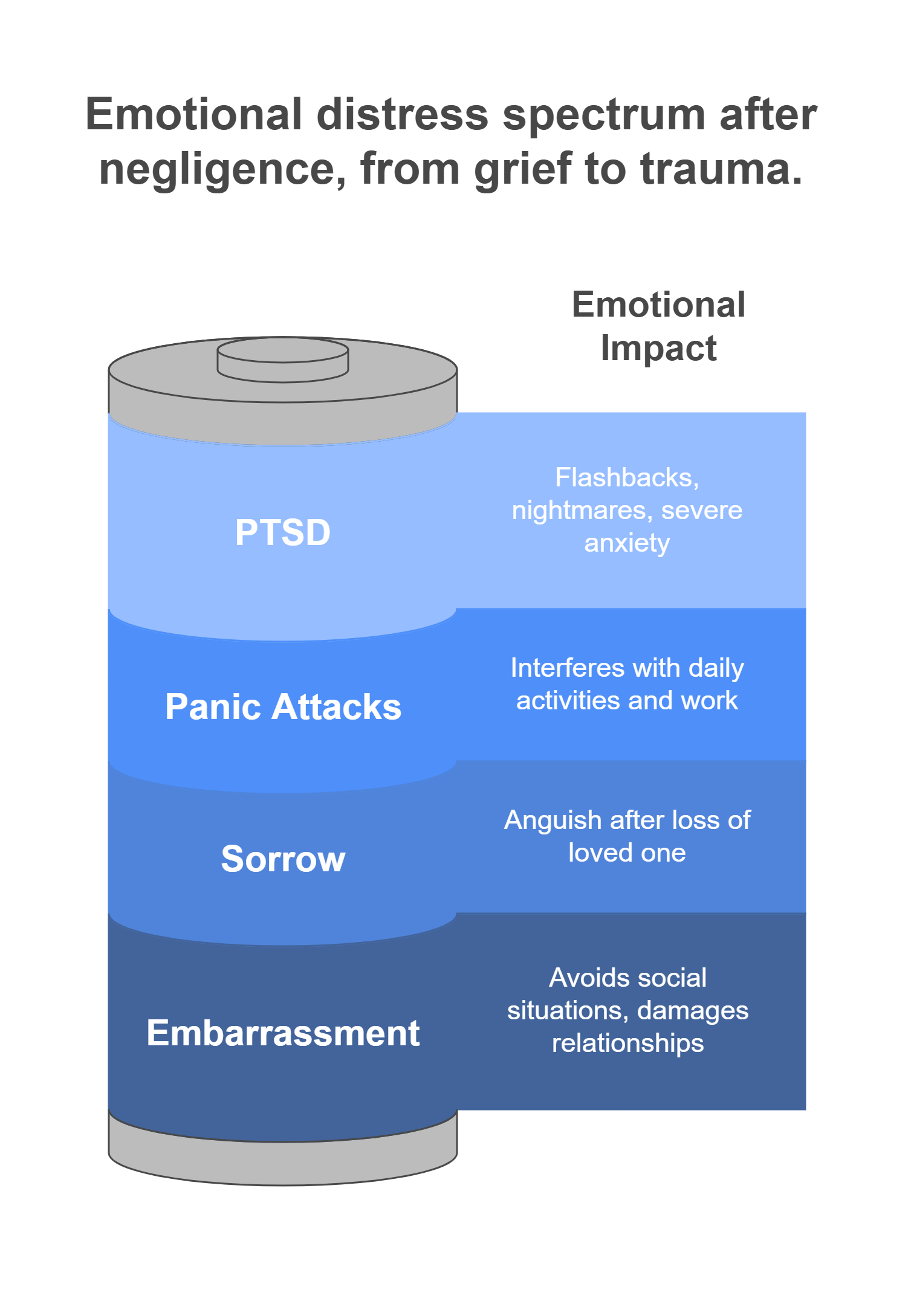Emotional Distress Lawsuit in California for Personal Injury: Ultimate Guide

Pursuing an emotional distress lawsuit in California requires knowing complex legal standards that differ from physical injury claims. California law recognizes the severe impact that emotional distress can have on a person’s life, allowing victims to recover damages for emotional distress through various legal avenues.
To successfully sue for emotional distress in California, you must establish these core elements:
- Evidence of severe emotional suffering or emotional pain
- A clear connection between the defendant’s actions and your emotional harm
- Documentation of your emotional distress through medical records, therapy notes, or witness testimony
- Proof that the emotional distress has significantly impacted your daily life
- Demonstration that the emotional trauma was reasonably foreseeable
The consequences of not properly addressing emotional distress can be devastating. Untreated psychological trauma often worsens over time, affecting relationships, work performance, and overall quality of life. Without legal representation, you may struggle to receive fair compensation that acknowledges the profound impact that emotional distress has caused.
Our personal injury lawyer in Torrance is available today for a free consultation to help you seek the compensation you deserve for your emotional suffering.
What is emotional distress in law?
In California, emotional distress refers to mental suffering that results from another person’s negligent or intentional actions. Getting to know emotional distress in a legal context is essential when pursuing compensation through a personal injury lawsuit. California courts recognize emotional distress as a compensable harm even without physical injuries in specific circumstances.
📌 According to the California Civil Jury Instructions (CACI), emotional distress damages can be recovered as a component of pain and suffering from a car accident in personal injury cases. The state’s approach is more progressive than many others that require physical injury to accompany mental anguish claims.
| Legal Element | Negligent Infliction (NIED) | Intentional Infliction (IIED) |
|---|---|---|
| Intent Required | No | Yes – extreme and outrageous conduct |
| Example | Witnessing a family member’s fatal accident | Persistent workplace harassment |
| Physical Harm Needed? | Sometimes | No |
| Evidence Required | Objective medical proof preferred | Must show severe distress and intent |
| Typical Complexity | Lower bar for filing | Higher threshold for success |
Is emotional distress a personal injury?
Yes, emotional distress in California is considered a personal injury under state law. The legal system recognizes that psychological injuries can be just as debilitating as physical ones. When pursuing a personal injury claim, you can include emotional distress as a significant component of your damages.
Mental health conditions resulting from traumatic events, such as anxiety disorders, depression, post-traumatic stress disorder (PTSD), or insomnia, qualify as legitimate injuries. These conditions often have measurable impacts on daily functioning and quality of life.
✔️ Someone experiencing debilitating panic attacks after witnessing a horrific car accident may have a valid claim, even without personally suffering physical injuries. California courts have established precedent for compensation in such cases through the “bystander” theory of recovery.
The intangible nature of emotional distress makes these claims challenging, but not impossible. Our experienced personal injury lawyer will help gather the necessary evidence to strengthen your claim and demonstrate the severity of your emotional distress to insurance companies or a jury.
Can you sue someone for emotional damage?
Yes, in California, you can sue someone for emotional damage under specific circumstances. Emotional distress claims in California typically fall into two primary types of emotional distress claims: those arising from negligence (like car accidents) and those stemming from intentional misconduct (such as harassment or abuse).
To prove emotional distress in court, you’ll need to demonstrate that the other party either intentionally caused you harm or acted with negligence. The severity of emotional distress required varies between intentional and negligent cases.
💡 Don’t assume physical injuries are necessary—California law recognizes the severe impact of purely psychological trauma in certain situations, particularly in intentional infliction of emotional distress cases where extreme emotional distress is the expected outcome of outrageous conduct.
Emotional harm from negligent actions must typically be severe and manifested through physical symptoms or documented mental health treatment. Courts examine factors including the intensity and duration of distress, any associated physical symptoms, and underlying psychological conditions.
How can you sue someone for emotional distress?
Filing an emotional distress claim requires careful preparation and knowledge of legal requirements. The process involves several critical steps to ensure your claim meets California’s standards for compensation.
- Determine if your case involves negligent infliction of emotional distress or intentional infliction of emotional distress to establish the appropriate legal standard.
- Gather comprehensive medical and therapy documentation that validates your emotional suffering and connects it to the incident.
- Identify all potentially responsible parties who contributed to your emotional distress through their actions or negligence.
- Ensure you file within California’s statute of limitations for personal injury claims to protect your right to sue.
- Consult with our qualified personal injury attorney who specializes in emotional distress cases to evaluate your claim.
The stronger your documentation and expert testimony, the more likely your emotional distress claim will succeed in settlement negotiations or at trial.
Examples of emotional distress damages
Emotional distress damages compensate for psychological suffering caused by traumatic events. These non-economic damages are intangible but very real consequences that can significantly impact a person’s life.
Common examples include:
- PTSD or trauma-related disorders that trigger flashbacks, nightmares, or severe anxiety when exposed to situations similar to the traumatic event.
- Anxiety and panic attacks that interfere with daily activities, work performance, or the ability to engage in previously enjoyable activities.
- Depression leading to social withdrawal, loss of interest in activities, sleep disturbances, or changes in appetite and energy levels.
- Humiliation or embarrassment that causes avoidance of social situations or damages personal and professional relationships.
- Grief, sorrow, or mental anguish following the death or serious injury of a loved one due to another’s negligence.
💡 These aren’t hypothetical symptoms—they represent real suffering that California courts recognize as compensable in personal injury cases with lasting psychological consequences.

Common scenarios of suing someone for emotional distress
Knowing real-world applications of emotional distress claims can help clarify how these cases work in practice. Here are two hypothetical scenarios illustrating different types of emotional distress claims in California.
Hypothetical Scenario #1:
A mother was picking up her child from school when she witnessed a distracted driver strike her 8-year-old son in the crosswalk. Though her son survived with moderate injuries, the mother developed severe anxiety, insomnia, and recurring nightmares. She required extensive therapy and medication to manage her symptoms.
Under California’s “bystander” theory of negligent infliction of emotional distress, she could recover damages for her psychological trauma because she was present at the scene, closely related to the victim, and suffered serious emotional distress as a result.
Hypothetical Scenario #2:
An individual endured months of deliberate, extreme harassment from a neighbor who regularly screamed profanities, made humiliating comments about them in front of other neighbors, and made threatening gestures whenever they attempted to leave their home.
The victim developed depression, suffered panic attacks before going outside, and eventually required hospitalization for suicidal ideation. This could qualify as intentional infliction of emotional distress because the neighbor’s conduct was extreme, outrageous, and intended to cause emotional harm.
A recent case from Feher Law resulted in a $4 million verdict for a client who suffered PTSD and a concussion in an auto crash (Flores vs. M&N Rug Enterprise, LLC). While physical injuries were present, a significant portion of the compensation addressed the psychological trauma that prevented the client from returning to normal activities for over a year.
How much can I sue for emotional distress in California?
California does not impose a specific cap on emotional distress damages in most personal injury cases. The amount you can recover depends on several factors, including the severity of your emotional distress, the impact on your daily life, and the strength of your supporting evidence.
For medical malpractice cases, the Medical Injury Compensation Reform Act (MICRA) limits non-economic damages to $350,000 (increasing to $750,000 by 2023 under recent legislation). However, this cap doesn’t apply to most other personal injury claims where emotional distress is a factor.
💡 Jurors evaluate the credibility of emotional distress claims based on consistency between your testimony, medical records, and expert witness statements. Cases with thorough mental health documentation and expert testimony from respected professionals typically receive higher damage awards.
Clients who maintain consistent therapeutic relationships and document how emotional distress impacts their daily functioning often secure more substantial compensation, as this creates a compelling narrative of genuine suffering.
Emotional distress is often a major component in personal injury claims, especially in cases involving severe trauma, such as a motorcycle accident pain and suffering settlement, where victims frequently experience PTSD, anxiety, or depression alongside physical injuries.
Our San Bernardino personal injury lawyer will provide a personalized assessment of your potential compensation during a free consultation.
How to calculate emotional distress damages in California
Determining the value of emotional suffering requires a systematic approach that accounts for both subjective experiences and objective evidence. The process involves multiple considerations to arrive at a fair compensation amount.
- Assess the severity and duration of your emotional harm through clinical diagnoses, treatment plans, and prognosis for recovery.
- Evaluate all documented therapy sessions, psychiatric care, and medication requirements as tangible evidence of your suffering.
- Measure impact on quality of life by documenting changes in sleeping patterns, relationships, work performance, and daily activities.
- Factor in whether your condition is likely temporary or permanent, as chronic conditions typically warrant higher compensation.
- Apply appropriate calculation methods, which may include the “multiplier method” or “per diem” approach, depending on your specific circumstances.
Below is a general framework for how multipliers might be applied in emotional distress cases:
| Impact Level | Symptoms | Documentation | Typical Multiplier Range |
|---|---|---|---|
| Mild | Temporary anxiety, minor sleep disturbances | Limited medical visits | 1.5-3x economic damages |
| Moderate | Depression, panic attacks, therapy needed | Regular treatment, medication | 3-4x economic damages |
| Severe | PTSD, major depression, hospitalization | Extensive treatment, expert testimony | 4-5x economic damages |
| Catastrophic | Suicidal ideation, inability to function | Inpatient care, permanent impairment | 5-10x economic damages |
The more comprehensively your mental health records document your trauma, the stronger position you’ll be in when negotiating a settlement or presenting your case to a jury.

Estimate your potential emotional distress damages
Our pain and suffering calculator provides a helpful starting point for knowing the possible value of your emotional distress claim. This free tool helps estimate compensation for psychological trauma, including PTSD, depression, anxiety, and grief resulting from another’s negligence or intentional actions.
The calculator considers several factors:
- The severity of your emotional suffering
- Duration of your symptoms
- Impact on daily activities
- Related medical and therapy expenses
- Any physical injuries accompanying the emotional trauma
✔️ Our calculator is specifically designed to address emotional distress damages in California, not just physical injuries. The psychological impact of traumatic events deserves proper compensation under the law.
Selected Value: 0%
Your compensation estimate may change significantly based on factors like comparative negligence. If you were partially responsible for the incident, your recovery could be reduced proportionally—our calculator helps visualize these potential scenarios.
Our Huntington Beach personal injury lawyer is available for a free consultation to provide more tailored guidance based on the specific details of your situation.
We understand you might not be ready to speak with someone immediately. Please fill out the form below, and we’ll contact you as soon as possible. Remember that time is of the essence in emotional distress claims!
"*" indicates required fields
Emotional distress statute of limitations in California
In California, you generally have two years from the date of the incident to file a lawsuit for emotional distress under California Code of Civil Procedure §335.1. This timeline applies whether your claim involves negligent infliction of emotional distress or intentional infliction of emotional distress.
If you wait too long to file your claim, you may permanently lose your right to pursue compensation, even if you have compelling evidence of severe emotional suffering.
Several exceptions can extend or “toll” this deadline in specific circumstances. For minors, the statute doesn’t begin until they turn 18. The “discovery rule” may apply when emotional harm isn’t immediately apparent. Cases involving government entities require filing an administrative claim within six months.
Pursuing emotional damages in a wrongful death claim
Family members who have lost a loved one due to another’s negligence or wrongful actions can pursue compensation for the emotional suffering caused by this loss. California law allows certain relatives to recover both economic and non-economic damages through wrongful death claims.
Recoverable emotional damages may include loss of love, companionship, comfort, care, assistance, protection, affection, society, and moral support. The relationship to the deceased significantly impacts the potential recovery, with spouses, children, and parents typically having the strongest claims.
⚠️ Even if you weren’t financially dependent on the deceased, you may still recover significant emotional distress damages based on the quality and closeness of your relationship.
California Code of Civil Procedure §§377.60–377.62 establishes who can file a wrongful death claim and what damages are recoverable.
Need expert legal advice on a lawsuit for emotional distress?
Filing an emotional distress claim requires specialized knowledge of California personal injury law and strategic documentation of your suffering. Our team has extensive experience helping clients recover damages for emotional distress, whether stemming from car accidents, assault, workplace harassment, or other traumatic events.
We understand the challenges in proving the severity of emotional distress and can connect you with qualified mental health experts to strengthen your claim. Our attorneys will guide you through every step of the legal process, from initial consultation through settlement negotiations or trial if necessary.
Contact us online or call today at (866) 646-6676 for a free, confidential consultation about your emotional distress case.

FAQs
Do I need a diagnosis to file an emotional distress claim?
While not absolutely required, having a formal diagnosis from a licensed mental health professional significantly strengthens your emotional distress claim in California. Documentation of conditions like anxiety, depression, or PTSD provides objective evidence of your suffering and helps establish the severity of your emotional distress due to the incident.
What if I've never seen a therapist—can I still sue?
Yes, you can still pursue an emotional distress claim without prior therapy, though it creates additional challenges. Your case will rely more heavily on testimony from friends, family, and coworkers who can verify changes in your behavior and emotional state. Starting therapy after the incident can help document the impact of emotional trauma.
Will my case be stronger if I also have physical injuries?
Generally, yes. Cases combining physical injuries with emotional distress typically have a clearer path to compensation since the psychological impact becomes more demonstrable. However, California law recognizes the severe emotional distress that can occur even without physical harm, particularly in cases of intentional infliction of emotional distress.
How long do emotional distress lawsuits usually take to settle?
The timeline for emotional distress claims varies widely, typically ranging from 6-24 months. Simple cases with clear liability and well-documented emotional suffering may settle within 6-12 months. Complex cases involving serious emotional trauma or disputed liability often take 12-24 months or longer, especially if they proceed to trial.
Related Posts

Facial Scarring Compensation Calculator in California

How Are Slip and Fall Settlements Calculated in California

Fatal Hit-and-Run in Santa Clarita Crash

19-Year-Old Severely Injured in Panorama City Crash




